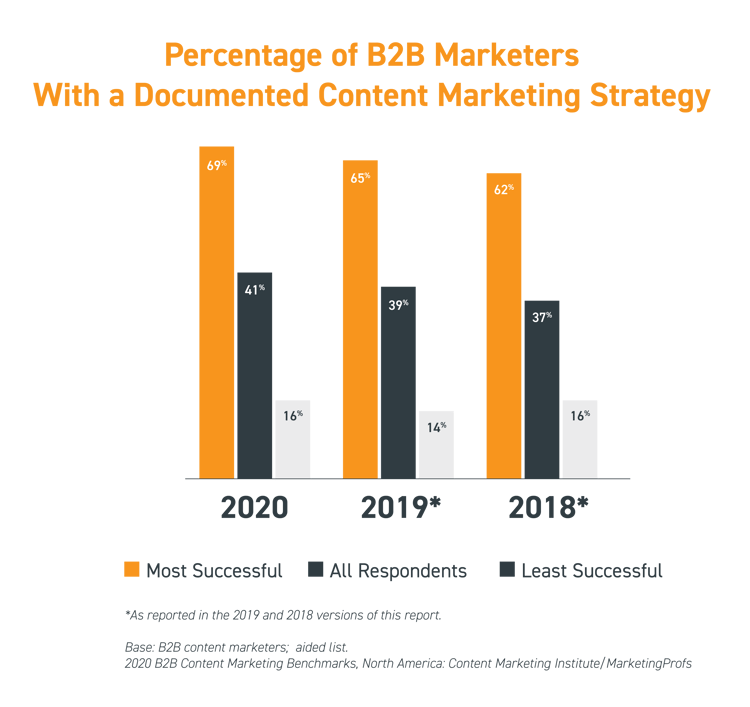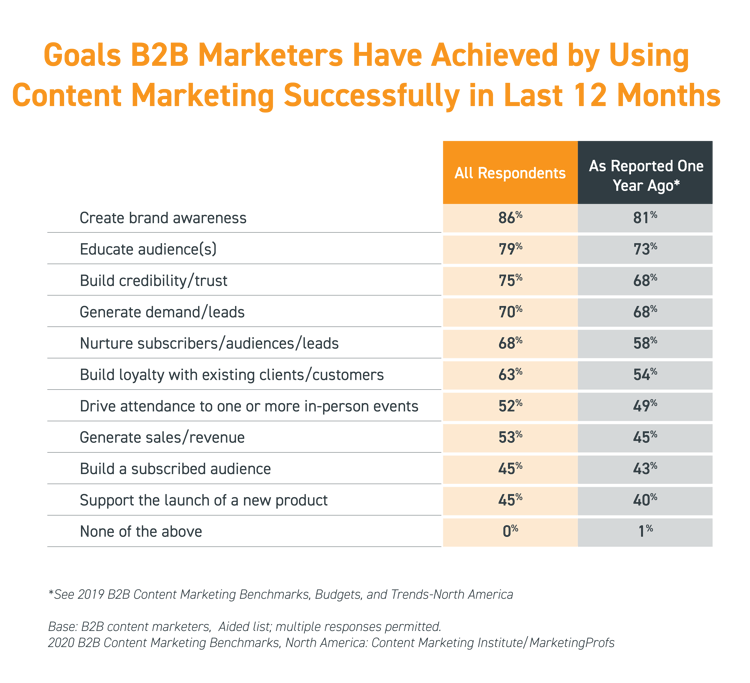Quality content marketing costs 62% less than traditional marketing and generates about three times as many leads. With 69% of the most effective marketers having a documented content strategy. Content marketing involves creating innovative, engaging and compelling content that results in a higher return on investment.

So how do you know if your content marketing is up to scratch? How do you plan a strategy, from start to finish, that will help deliver results?
Here are eight simple steps to help you plan your content marketing strategy.
Step 1: Establish your content marketing goals and KPIs
What do you want to achieve? What are the desired results of this content marketing strategy? Where do you want to improve your client or potential customer outreach? These are the types of questions to start with. It’s important to understand the ‘pain points’ for your content marketing strategy. Without them, you risk investing in the wrong area for and miss opportunities that may lead to growth.
Your content marketing goals could be to:
- Increase lead generation and sales
- Drive website traffic and improve SEO rankings
- Improve brand influence, authority or perception
- Decrease marketing costs e.g. cost per lead or cost per acquisition
- Enhance social media presence and engagement.
Establishing your content marketing strategy goals at the start It will help form the overall ‘umbrella’ to ensure that every action you set, every consideration and discussion relates back to the overall goal. Like any plan, it can be easy to stray or get too caught up in brainstorming ideas, so your goal must be thoroughly communicated across all team members and departments who will play a part in achieving it. That way, you can keep each other accountable and at the end of each step, ask the question: “How will this help achieve this goal and are we on the right track?”.
Effective goal setting means your business is one step closer to a successful content marketing strategy.

Bring it back to basics. Don’t over complicate your goals either. If you are new to goal-setting, consider the SMART approach:
- S: Specific answers the what, why, where, who and which questions
- M: Measurable means you actually ‘see’ results, whether that be monetary or percentage-based
- A: Attainable keeps your goal realistic and possible to achieve
- R: Relevant ensures it is worthwhile and in line with other business goals or plans
- T: long-term phases.
Or, even the FAST method:
- F: Frequently discussed to keep focused and on track
- A: Ambitious to promote innovation
- S: Specific with milestones and measurable metrics
- T: Transparent across all involved teams.
TIP: Start small. Don’t try to increase revenue and or drive more traffic to your website if you do not have the funds or the time to invest in this strategy completely.
Step 2: Create a target audience profile or ‘persona’
The content you create as part of your content marketing strategy needs to target a particular audience. It won’t be as effective if you don’t understand your target audience’s profile or how they like to interact with brands. For instance, only 22% of millennials react to email marketing, while 57% of those in Gen X would rather receive content that way.
The target audience profile for your content marketing strategy isn’t always the same as your target audience profile for your brand. While it’s normal to assume they would be, it depends on your goals. Your brand may have several target audiences depending on the industry you are in and the product or service you are offering. Your content marketing strategy essentially hones into one of those target audiences and it’s useful to create a subdivision called a buyer persona to ensure your content resonates with its intended audience.
To create a buyer persona or specific target audience profile you need to establish who your content marketing strategy is addressing:
- The demographic: Are you aiming to reach millennials, parents or people living alone? What level of education are they familiar with? Gender? Income?
- Their personal interests: What do they enjoy doing in their spare time and how can your content strategy weave into any pain points there?
- Their behaviours and characteristics: Are they laid-back, do they enjoy a challenge, or prefer to go to a library over a concert?
- Their shopping habits: Are they online shoppers? Do they buy in bulk or prefer unique pieces?
- Their online content preferences: Do they use social media a lot? Are they more professional and respond better to emails, or do they still watch the news and read educational articles?
If you have an existing customer base, then ask for feedback to help build your target audience profile. Ask them their response to the current content your business is producing, their current needs, what they would like to see more of and how future content can address their issues. All of this can really help your business understand your customer’s priorities and decide where to meet them.
TIP: There are many already built-in systems to several online platforms that can provide you with some of this data quickly based on previous online brand interactions: Google Analytics, Facebook and Twitter Analytics to name a few. Check if any of your social platforms have this before doing your own research as this can save you time.
Step 3: Identify your tone of voice
The way you write, the 'brand personality' you display through your content, whether written or verbal, needs to be consistent and stand out. It needs to reach your target audience, pique their interest and make them want to engage with the content you produce.
For example, if your target audience is highly educated or at a scholar's level, you might refrain from using slang words or having the tone be too relaxed. On the other hand, if your target audience is Gen Z, millennials or people who use social media frequently, slang words would be preferred over complete sentences.
How do you identify your tone of voice? Well, you identified how your target audience likes to be communicated with. Now weave that into your own brand’s values. Focus on asking yourself: who we are, who we want to be and who we are not. It is not just what you say, but more how you say it. How do you want your content marketing strategy to come across to your target audience? Let this guide you in the way you create your content marketing strategy.
TIP: Each time you create content, reflect on the tone. Is it similar to what your target audience is currently reading and at the same time, does it speak to your goals and what you want this piece of content to achieve?
Step 4: Identify your content channels
When establishing your target audience profiles or buyer's personas, you would have come across data showing where they like to 'hang out'. Essentially, figure out where your content will get the attention you want it to get.
Consider doing some more market research, in addition to the data you collected from your target audience analysis. Take a look at how your competitors are using their marketing channels. Read articles, attend industry conferences to learn what channels are up-and-coming for your demographic.
Set aside a test period to trial different types of content across several channels and measure the results before committing to one. By allocating a test budget, you anticipate the risk and can collate valuable data to amplify your live strategy.
Examples of popular content channels include:
- Social media: Facebook, Instagram, Twitter, LinkedIn and Pinterest as examples
- Paid promotions: pay-per-click advertisements
- Email and text marketing: effective if you have an up-to-date customer relationship management (CRM) system that can provide existing client and prospect contact details
- Print media: tap into more traditional paid advertising methods and public relations marketing across newspapers and even ‘niche’ magazines for your demographic.
Step 5: Establish content types
There are numerous different content ‘types’ to choose from for your content marketing strategy, and deciding on just one, two or a few to use can be overwhelming. It ultimately comes down to the research you have done on what your competitors are using, what is feasible in terms of time and money to create and how your target audience will interact with the content.
Here are some of the essential content types to get started with. ‘Essential’ meaning that they are commonly used and easier to manage.
- Articles
- Podcasts or webinars
- Blog posts
- Case studies
- E-books
- E-courses
- Email marketing
- Infographics
- Newsletters
- Photos
- Presentations
- Promotions
- Social campaigns
- Videos
- White papers.
Step 6: Create a content calendar
So, you've created a bunch of content. How are you going to get this out to your target audience in the most efficient way? How do you keep track of posting when your followers are 'most active' or how do you ensure that you are maintaining a social media presence? Easy: a content calendar.
Many applications and templates are available, such as a social media posting template, to help keep on top of content distribution.
Other applications include something as simple as Google Calendar to get started. These 'calendar' applications are suited for businesses that are not posting a lot of content but can get quite messy when your content creation starts to pick up. In that case, Asana or a purpose-built content mapping calendar like CoSchedule, can make things easier.
Step 7: Plan, create and develop your content
This step is when all the previous ones come together. Step 1 through to 6 will have provided the baseline information for you to start planning, writing and creating your content with your team(s).
Each time you create a piece of content, research how the market will react to your content.
Should you create this now or maybe, it will receive better feedback from your target audience in a few months?
As you go about creating, keep in mind your tone of voice, the target audience profile and important SEO ranking factors.
TIP: If possible, try and have another person proof your content before it goes to market. This is important to make sure that someone else can understand the underlying message and offer improvement suggestions.
Step 8: Distribute content to market and measure results
This step is different to creating a content mapping calendar. This is more around actioning and what happens when it gets to that point on the calendar that you need to distribute the content and ensure you have the processes in place to measure the results of your content marketing strategy.
Make sure you have everything ready to post, send or distribute at the given time for that piece of content. Say for a social media post, do you have the social copy approved, graphic design imagery completed and the link ready for the post? Or, for a customer newsletter, is your customer list up-to-date and not missing contact information?
Once you have everything checked off, it’s as easy as getting it out to the market and then starting to measure the results of your content marketing strategy.
Return to the above Step 1 and review your KPIs, the goals you set out to achieve for this specific strategy and the results you are starting to see come through. You can measure this by:
- Using Google Analytics or other free online platforms to see how your content is performing
- Check social sharing activity or social analytic platforms to understand how your target audience is reacting
- Review conversion analytical dashboards or internal business systems that can provide further insight.
This step is crucial, as this is where you learn, where you understand what needs to change for your next content marketing strategy, what worked, what went wrong and how to optimise in the future.
What next?
Now that you know how to create a content marketing strategy from scratch, why not consider hiring additional sales and marketing support to help free up your time? Outsourcing can take care of transactional, repetitive and time-consuming tasks while you focus on building strategies and nurturing business relationships for your marketing team. This free eBook covers 107 different ideas to help maximise your business’ sales and marketing results.














































.jpg?width=299&height=196&name=Mega%20Menu_FAQs%20(1).jpg)








